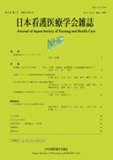Japanese
English
- 有料閲覧
- Abstract 文献概要
- 参考文献 Reference
要約
85名の母親を対象に、初乳中IL-1α、IL-1β濃度の含有量について明らかにし、その母親の特性との関係について検討をした。分析については酵素免疫測定法を用い、母親の特性は、産科学的因子について情報を得た。初乳中IL-1α、IL-1βの平均濃度は、19.6±12.7pg/ml,53.7±106.6pg/mlであり、基本統計値から母親による大きな個体差を認めた。Cytokineは、刺激により局所的に産生される液性因子であることから、分娩期に母親が受けた刺激因子について関連性を統計学的に分析したところ、IL-1αは分娩所要時間、分娩時出血量、子宮収縮の強度、胎盤実質重量、感染という因子の関連性が挙げられた。これら分娩時の刺激因子により、より高濃度のIL-1αが分泌されるという科学的事実は、入院中の授乳計画に反映され、根拠に基づく看護実践になると考えられる。
Abstract
Interleukin-1α and interleukin-1β concentrations in human colostrum from 85 mothers were investigated by enzyme immunoassay. The reletions between the interleukin-1 concentrations and maternal obstetric factors were examined.
The mean values and standard deviation of the interleukin-1α and interleukin-1β concentrations were 19.6±12.7 pg/ml and 53.7±106.6 pg/ml, respectively. Wide variations in interleukin-1α and interleukin-1β concentrations among individuals were found in human colostrum at 3 days postpartum. Among the obstetric factors, duration of labor, amount of postpartum bleeding, intensity of uterine contractions, placental weight, and infection were significantly correlated with the concentration of interleukin-1α , suggesting that interleukin-1α-stimulating factors during delivery promoted the secretion of interleukin-1α in the mammary glands.
These finding showed that the colostrum of stimulant mothers during delivery contains more interleukin-1α . These scientific facts are reflected in a breastfeeding plan and are evidence based on nursing practice.
Copyright © 2000, Japan Society of Nursing and Health Care All rights reserved.


